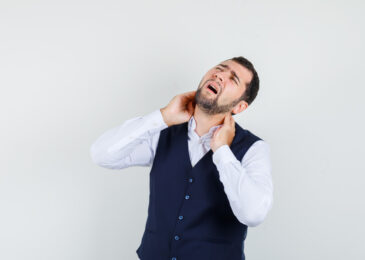
Chronic or�Sinus infection Neck Pain can be a sign of cervical cancer for older people, according to a recent scientific study in the United States.
Sinus Infection Neck Pain is an inflammatory condition which causing by viral or bacterial infections and is a chronic condition when it lasts more than 12 weeks and may be linked to head and neck cancer (HNCs ) due to lack of immunity or increased inflammation.
In the study of the Sinus infection Neck Pain:
Which including more than 5,000 people, the association of sinus infection neck pain with the risk of neck cancer was found at 58 percent, especially pharyngeal cancer?
The findings also support the need for cervical cancer in people with Sinus infection Neck Pain, the researchers said.
Sinus Infection Neck Pain leads to a headache in the head, and pain behind the ear is associated with otitis media.
This inflammation in the sinuses lead to obstruction of the nose, headache, and inability to breathe well, especially during sleep, and leads to congestion of the throat; Breathing can only be done by mouth.
Sinus infection Neck Pain to the nose:
Can be treated with inhalation with salty water several times a day, such as ablutions completely, by dissolving half a teaspoon of salt in a large glass of water, using a spray of Rhinocort, a cortisone sprayer, After cleaning the nose with salt water for a Yam.
Sinus Infection Neck Pain Causes and Treatment:
- Causes of�Sinus Infection Neck Pain
Sinus infection of neck pain is an infection caused by bacteria.
These bacteria in the nose are not harmful, nor do they cause problems when they penetrate into the sinuses, as long as they descend after penetration into the nose again. However, if the sinus passages are clogged, the bacteria multiply causing the infection.
The obstruction of high sinus discharge channels is, therefore, the main cause of sinusitis, and the reopening of the discharge pathways is the key to treatment.
- Triggers of Sinus Infection Neck Pain
Cold is one of the things that triggers or stimulates sinusitis. The normal person gets from 2 to 3 flu a year on medium, and the kid gets six to 10 drops. Flu is causing by viruses, not by bacteria, so antibiotics are not useful in treating them.
However, viruses cause swollen nasal tissue, sometimes leading to sinus obstruction. The cold also switches the shape of the mucus, preventing it from performing its normal role in catching bacteria.
You may feel a bit of pressure in the Sinus Infection Neck Pain when you get flu, but that does not mean you’ve got it or you need antibiotics. Only one of 1000 colds lead to sinusitis. You can avoid inflammation by emptying the sinuses.
You can also improve Sinus Infection Neck Pain by:
- Thinning out of the nose, as strong stabbing can push the bacteria up toward the sinuses. And many other things can plug sinuses and lead to infection.
- The list includes sinus infection neck pain, cigarette smoke and other fumes, changes in air pressure during flight or diving, nasal buildup, and nasal membrane dissection.
Symptoms of�Sinus Infection Neck Pain:
- Painful pressure is the main symptom. The pain depends on the location of the inflamed pockets. The pain is in the front when the frontal sinuses, the upper jaw,the upper jaw, the teeth (the sinuses), the back of the eyes (the sinuses) or the top of the head (the sinuses). Increasingly sinus pain usually when bending forward.
- The symptoms of nasal congestion are also common, and secretions appear in dark colors from the nose. When the mucus droplets drop from behind the nose to the pharynx, you will feel a foul taste,and you may have a foul odor in your mouth or cough. You may briefly lose your sense of smelling or taste, and finally, you may feel fever, aches, and fatigue.
Diagnosis�of�Sinus Infection Neck Pain
In most cases, the doctor can diagnose the sinus infection neck pain, asking the symptoms. If the pressure on the sinuses causes pain, you have the most inflammation.
Computed tomography may play a role in diagnosis if sinus infection neck pain is exceptionally severe. If a doctor suspects complications, X-rays are less useful.
Treatment�of�Sinus Infection Neck Pain
- Discharge
Many people with�Sinus Infection Neck Pain�will quickly recover completely, without taking antibiotics, and simply by following the method of discharge.
- Drink plenty of water:
As it helps keep the mucus light and fluid.
- Steaming steam:
Take a long bath in the hot shower,�Pour the water into a jug, then put it in a saucepan, and put it over the pot after covering your head with a towel.
Steam inhaled,�Confidentiality and here are the elements in the steam. Try to breathe steam 3 to 4 times a day.
- Your head is high:
If you have pain on one side only, place your free side of the face on the pillow.
- Use depressants:
Cereals containing pseudoephedrine or phenylephrine are very helpful, but they often lead to elevated blood pressure, faster heartbeat, confusion, and restlessness.
However, the nasal sprays of phenylephrine or oxymetazoline do not have these side effects. But the most useful and for long periods may lead to scratching the nose or become permanently dependent on it.
- Consult your doctor about the prescriptions of steroid sprays:
Especially if you have allergies or if your sinusitis is of the “stubborn” type.
- Use salt water sprays:
To liquefy mucus and wash nasal sinuses.
- Avoid antihistamines:
It is great for allergies, and when you run your nose in the cold, it increases the thickening of the mucus, which is difficult to discharge, and this is the last thing you want in the infection of sinuses.
- Warm compresses on your face may relieve the pain:
The pain relievers sold over-the-counter such as aspirin, or asstaminophen help relieve pain and fever.
- Antibiotics
- You may be surprising to learn that antibiotics are not on the list of the first treatments for Sinus Infection Neck Pain. But thanks to successive television and press releases, most people with sinusitis are expected to receive antibiotics, while most doctors provide them with antibiotics.
- Indeed, antibiotics are having a major step forward in the treatment of sinusitis – but they do not function unless a good discharge is achieving. If a good discharge is found, antibiotics are not necessary.
In its quality enhancement, antibiotics have potential deficiencies.
- They can trigger allergic reactions or lead to side effects. The increased use of antibiotics has led to the spread of antibiotic bacteria (superior bacteria). finally, a lot of this medicines are expensive.
- However, if sinusitis did not improve within 2 to 4 days of discharge therapy – or the inflammation was severe from the start – the doctor would prescribe antibiotics.
- Because resistant bacteria often live in the nose and sinuses, it is logical to use one of the new antibiotics directed against these bacteria.
- But, logically or illogically, a number of studies have suggested that older, less expensive antibiotics are also as effective as new drugs that attack resistant bacteria.
- For the same reason, experiments have shown that antibiotic therapy for 3 to 7 days is generally as effective as conventional treatment for 10 to 14 days for uncomplicated sinusitis.
- Many bacteria can cause acute sinusitis. Unless you have a perforation in the sinuses the type of bacteria that cause sinusitis cannot be identified in any way.
- The contents of the mucus or nose are planting in the laboratory do not help much here because they are filling with bacteria that live inside the nose.
In addition to the bacteria that cause�sinus infection neck pain,�staphylococcus, anaerobic bacteria, and fungi can cause chronic sinusitis.
- Antibiotics may be especially useful for treating seizures, but they are less important than nasal irrigation, decongestants, and medically prescribed nose sprays.
- If there is an allergy, antihistamines will be helpful. In severe cases, it is necessary to use oral steroids. As with cases of acute sinusitis, successful treatment here is discharge.
- In cases of chronic sinusitis, surgery may be necessary. Doctor can also remove nasal placenta, or repair the membrane, or use the telescope to open a channel to discharge between the sinuses and between the nose
Sinus Infection Neck Pain and its types:
- There are four pairs of air-filled nasal pockets in the bones surrounding your nose:
- Front sinuses are located behind the front of the head.
- Maxillary sinuses lie behind the bones of the cheeks.
- Sinusoidal sinuses located behind the nasal bridge.
- Sphenoid sinuses are located deep inside the skull, behind the nose.
- Living with sinusitis It is nice to know that CT scans and laparoscopy have become available to assess or treat acute or chronic sinusitis.
Fortunately, Sinus infection neck pain responds to much simpler treatments.
How to protect your Nasal Pockets:
- keep your body hydrated. Avoid smoking cigarettes and harmful smokes. And if you have allergies, avoid the things that worsen the condition. Avoid getting colds, repeat washing hands well and keep away from colds.
- When you have a cold, it is properly spraying to prevent the bacteria from penetrating into the sinuses. Treat the symptoms of sinusitis quickly by inhaling steam, relieving the congestion, and running the nose.
- If you are not curing as you were – or you have severe sinusitis or serious symptoms – see your doctor for antibiotics and possibly nasal steroids.
- Doctors know very well why they have sinusitis and what role they give us, but they do not know what bad things can happen because of inflammation. And Acute sinusitis is common and uncomfortable. But knowing how to keep your nasal pockets open and freeing them, you can keep them healthy and healthy.





